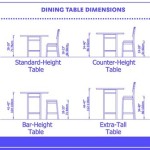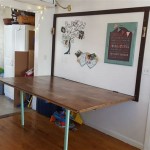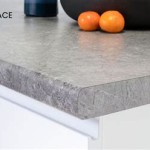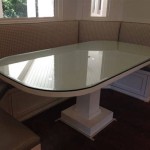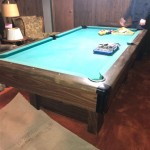Table With Bench Seating: A Comprehensive Overview
Table with bench seating arrangements represent a popular and versatile choice for both residential and commercial spaces. Their functionality extends beyond mere dining, offering opportunities for social interaction, efficient space utilization, and a distinctive aesthetic. This article will explore the various aspects of table with bench seating, including its advantages, design considerations, material choices, and practical applications.
The fundamental concept of table with bench seating involves replacing traditional chairs with benches, typically positioned along one or both sides of a table. This configuration presents a number of unique characteristics that contribute to its appeal.
Space Efficiency and Seating Capacity
One of the principal advantages of bench seating is its space-saving nature. In comparison to individual chairs, benches can accommodate more people within a given area. The absence of gaps between seating positions common with chairs allows for a higher density of occupants at the table. This becomes particularly beneficial in smaller dining rooms, kitchens, or communal spaces where maximizing seating capacity is a priority.
Furthermore, benches can be pushed completely under the table when not in use, freeing up floor space and improving traffic flow within the room. This adaptability proves valuable in environments where the use of the table varies throughout the day, such as in breakfast nooks that transition into play areas, or in restaurants where seating arrangements might need to be adjusted based on customer demand.
The continuous surface of a bench also allows for flexible seating arrangements. Individuals can easily slide along the bench to find a comfortable position or to make room for others. This adaptability makes bench seating ideal for accommodating varying group sizes, from intimate gatherings to larger family meals.
Enhancing Social Interaction and Creating a Communal Atmosphere
Table with bench seating fosters a sense of community and encourages social interaction. The shared bench eliminates the physical separation created by individual chairs, promoting a feeling of togetherness among individuals seated at the table. This can be particularly desirable in family settings, where mealtimes are viewed as opportunities for bonding and conversation.
In commercial settings, such as restaurants or cafes, bench seating can contribute to a more casual and inviting atmosphere. It encourages customers to interact with one another and can create a more vibrant and social environment. This is especially true in communal dining areas, where bench seating promotes interaction between individuals who may not know each other. The shared experience of sitting on the same bench can break down social barriers and foster a sense of camaraderie.
The design of bench seating can also influence the overall ambiance of a space. Benches can be incorporated into booths, creating cozy and intimate dining areas. Alternatively, freestanding benches can provide a more open and airy feel, depending on the desired aesthetic.
Design Considerations and Material Choices
Selecting the appropriate materials and design for a table with bench seating arrangement is crucial for ensuring both functionality and aesthetic appeal. A variety of factors must be considered, including the intended use of the table, the overall style of the room, and the desired level of durability and maintenance.
Wood remains a popular choice for both tables and benches, offering a warm and inviting aesthetic. Different types of wood, such as oak, maple, walnut, and pine, each possess unique grain patterns and color variations, allowing for customization to suit different design preferences. Hardwoods are generally more durable and resistant to wear and tear, making them suitable for high-traffic areas. Softwoods, while less expensive, may require more frequent maintenance and are more prone to scratches and dents.
Metal frames can provide a modern and industrial look, offering a strong and stable base for both the table and benches. Metal can be combined with wooden or upholstered seats for a more comfortable and aesthetically pleasing design. Stainless steel is a durable and corrosion-resistant option, making it suitable for outdoor use or in environments where hygiene is a concern.
Upholstered benches offer enhanced comfort and can add a touch of elegance to a dining area. A wide range of fabrics, including leather, velvet, and linen, can be used for upholstery, allowing for customization to match the overall décor of the room. Durable and stain-resistant fabrics are recommended for benches that will be used frequently.
The dimensions of the table and benches should be carefully considered to ensure comfortable seating and adequate legroom. The height of the bench should be appropriate for the table height, allowing individuals to sit comfortably without feeling cramped. The depth of the bench should also be sufficient to provide adequate support. The length of the bench will determine the number of people that can be comfortably seated.
Practical Applications in Various Settings
Table with bench seating arrangements find applications across a wide range of settings, from residential homes to commercial establishments. Their versatility makes them a suitable choice for various dining and gathering spaces.
In residential settings, table with bench seating is commonly found in kitchens, dining rooms, and breakfast nooks. Benches can be incorporated into built-in banquettes, creating cozy and functional dining areas. Freestanding benches provide flexibility and can be easily moved around the room as needed. Table with bench seating is an ideal choice for families with children, providing ample seating for meals and other activities.
Restaurants and cafes frequently utilize table with bench seating to maximize seating capacity and create a casual and inviting atmosphere. Benches can be arranged in booths or along walls, providing comfortable and efficient seating for customers. Communal tables with bench seating encourage interaction between patrons and foster a sense of community.
Outdoor spaces, such as patios and decks, also benefit from table with bench seating. Durable and weather-resistant materials, such as teak wood or powder-coated metal, are recommended for outdoor applications. Table with bench seating can create a welcoming and functional outdoor dining area for family and friends.
Educational institutions and libraries also utilize table with bench seating in communal areas. This provides students with a comfortable and collaborative space to study, work on projects, and socialize. The ability to accommodate multiple individuals at a single table makes it an efficient use of space in these environments.
Furthermore, the use of table with bench seating extends to office environments. Companies often implement these setups in break rooms or informal meeting areas. The communal nature encourages teamwork and facilitates more approachable team dynamics within the workspace. Bench seating promotes a more relaxed and less formal atmosphere, encouraging open communication and collaboration.
Ultimately, the longevity and aesthetic appeal of table with bench seating are directly related to the attention given towards proper maintenance. Regular cleaning and protective measures are essential for preserving the materials used and extending its lifespan.

The Secret To Using Bench Seats In Any Dining Room

Banquette Seating Kitchen Dining And Industrial Table Bench Set Oak

The Beauty Of Benches Classy Dining Room Table With Bench Rustic

Industrial Tan Faux Leather Padded Bench Seat Woods Furniture

Estudiofurniture Millbrooke Live Edge Acacia Wood Dining Table Bench Set Temple Webster

Dining Table With Mismatched Chairs A Guide Grain Frame
Bourton Dining Table Bench Seat Pad 3 Chairs Set Sterling Home

Dining Bench Vs Chairs Which Should I Choose

Bench Seating And Dining Table Traditional Room Cleveland By Robin Storie Houzz Ie

Diy Farmhouse Bench Love Grows Wild


